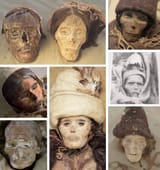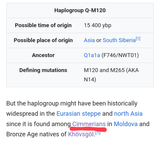Anonymous
7/20/2025, 5:12:58 PM No.17857784
A 2021 study ( https://www.nature.com/articles/s41586-021-04052-7 ) found that the earliest inhabitants of the Tarim Basin (dated Early to Middle Bronze Age, 2100 to 1700 BC, and pictured above) were not Indo-European Tocharians, but a population descended from Ancient North Eurasians. Such populations were common across Central Asia and West Siberia from the Mesolithic to Bronze Age (e.g. the Botai).
The newly published study ( https://www.cell.com/current-biology/abstract/S0960-9822(25)00815-2 ) investigated a Late Bronze Age site in the far west of the Tarim Basin, dated 1600 to 1400 BC. Its inhabitants overwhelmingly descended from the Indo-European Sintashta population, with additional ancestry from BMAC (10%) and Tarim_EMBA (12%). In terms of genetic similarity, they were most closely related to modern Northern Europeans, particularly Finnic and Russian people.
Admixture between Sintashta and Tarim_EMBA dated to around 2000 BC, indicating Indo-European settlement began during the Early to Middle Bronze Age.
The newly published study ( https://www.cell.com/current-biology/abstract/S0960-9822(25)00815-2 ) investigated a Late Bronze Age site in the far west of the Tarim Basin, dated 1600 to 1400 BC. Its inhabitants overwhelmingly descended from the Indo-European Sintashta population, with additional ancestry from BMAC (10%) and Tarim_EMBA (12%). In terms of genetic similarity, they were most closely related to modern Northern Europeans, particularly Finnic and Russian people.
Admixture between Sintashta and Tarim_EMBA dated to around 2000 BC, indicating Indo-European settlement began during the Early to Middle Bronze Age.
Replies:





